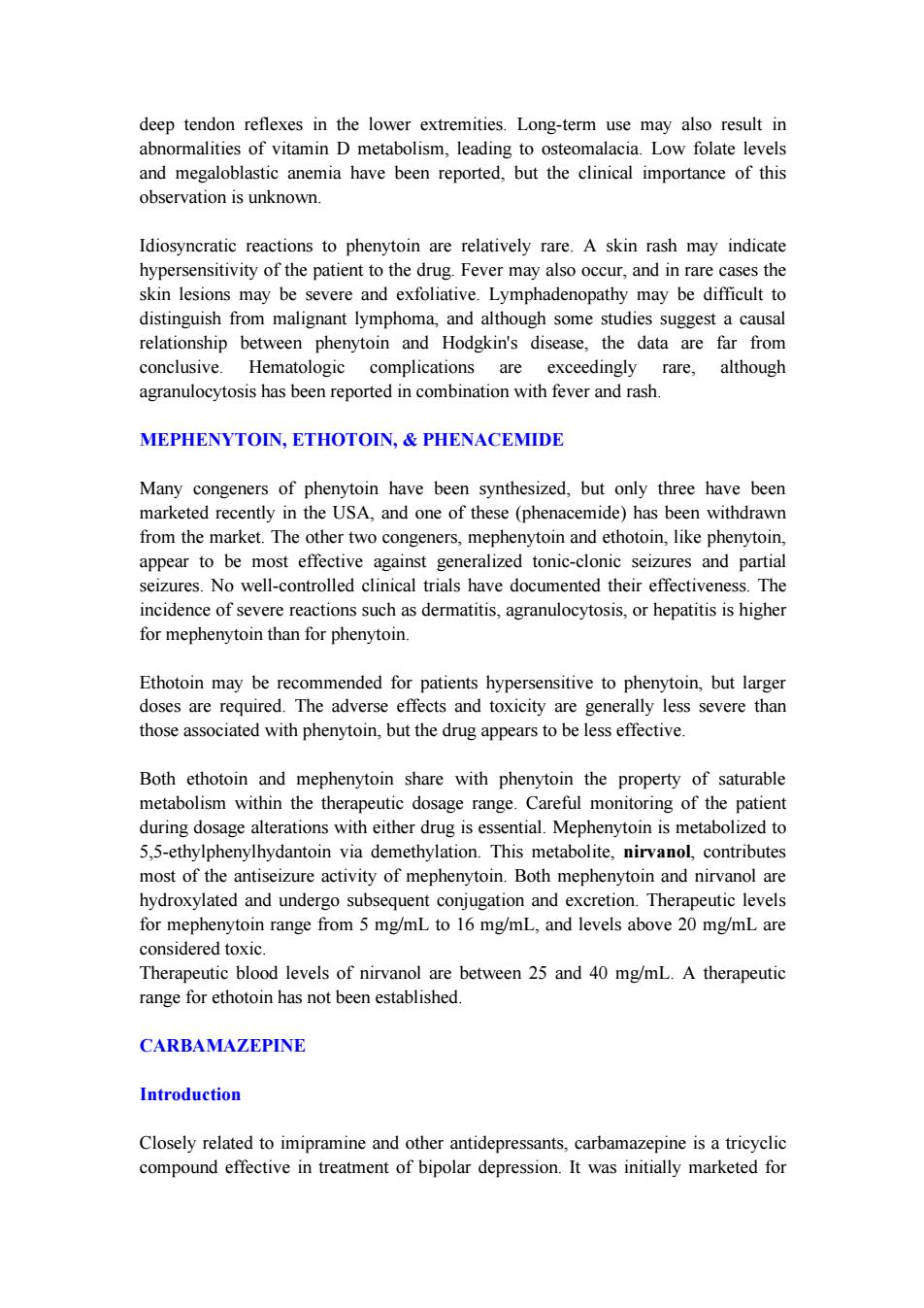正在加载图片...

deep tendon reflexes in the lower extremities.Long-term use may also result in abnormalities of vitamin D metabolism,leading to osteomalacia.Low folate levels and megaloblastic anemia have been reported,but the clinical importance of this observation is unknown. Idiosyncratic reactions to phenytoin are relatively rare.A skin rash may indicate hypersensitivity of the patient to the drug.Fever may also occur,and in rare cases the skin lesions may be severe and exfoliative.Lymphadenopathy may be difficult to distinguish from malignant lymphoma,and although some studies suggest a causal relationship between phenytoin and Hodgkin's disease,the data are far from conclusive.Hematologic complications are exceedingly rare,although agranulocytosis has been reported in combination with fever and rash. MEPHENYTOIN,ETHOTOIN,PHENACEMIDE Many congeners of phenytoin have been synthesized,but only three have been marketed recently in the USA,and one of these (phenacemide)has been withdrawn from the market.The other two congeners,mephenytoin and ethotoin,like phenytoin, appear to be most effective against generalized tonic-clonic seizures and partial seizures.No well-controlled clinical trials have documented their effectiveness.The incidence of severe reactions such as dermatitis,agranulocytosis,or hepatitis is higher for mephenytoin than for phenytoin. Ethotoin may be recommended for patients hypersensitive to phenytoin,but larger doses are required.The adverse effects and toxicity are generally less severe than those associated with phenytoin,but the drug appears to be less effective. Both ethotoin and mephenytoin share with phenytoin the property of saturable metabolism within the therapeutic dosage range.Careful monitoring of the patient during dosage alterations with either drug is essential.Mephenytoin is metabolized to 5,5-ethylphenylhydantoin via demethylation.This metabolite,nirvanol,contributes most of the antiseizure activity of mephenytoin.Both mephenytoin and nirvanol are hydroxylated and undergo subsequent conjugation and excretion.Therapeutic levels for mephenytoin range from 5 mg/mL to 16 mg/mL,and levels above 20 mg/mL are considered toxic. Therapeutic blood levels of nirvanol are between 25 and 40 mg/mL.A therapeutic range for ethotoin has not been established. CARBAMAZEPINE Introduction Closely related to imipramine and other antidepressants,carbamazepine is a tricyclic compound effective in treatment of bipolar depression.It was initially marketed fordeep tendon reflexes in the lower extremities. Long-term use may also result in abnormalities of vitamin D metabolism, leading to osteomalacia. Low folate levels and megaloblastic anemia have been reported, but the clinical importance of this observation is unknown. Idiosyncratic reactions to phenytoin are relatively rare. A skin rash may indicate hypersensitivity of the patient to the drug. Fever may also occur, and in rare cases the skin lesions may be severe and exfoliative. Lymphadenopathy may be difficult to distinguish from malignant lymphoma, and although some studies suggest a causal relationship between phenytoin and Hodgkin's disease, the data are far from conclusive. Hematologic complications are exceedingly rare, although agranulocytosis has been reported in combination with fever and rash. MEPHENYTOIN, ETHOTOIN, & PHENACEMIDE Many congeners of phenytoin have been synthesized, but only three have been marketed recently in the USA, and one of these (phenacemide) has been withdrawn from the market. The other two congeners, mephenytoin and ethotoin, like phenytoin, appear to be most effective against generalized tonic-clonic seizures and partial seizures. No well-controlled clinical trials have documented their effectiveness. The incidence of severe reactions such as dermatitis, agranulocytosis, or hepatitis is higher for mephenytoin than for phenytoin. Ethotoin may be recommended for patients hypersensitive to phenytoin, but larger doses are required. The adverse effects and toxicity are generally less severe than those associated with phenytoin, but the drug appears to be less effective. Both ethotoin and mephenytoin share with phenytoin the property of saturable metabolism within the therapeutic dosage range. Careful monitoring of the patient during dosage alterations with either drug is essential. Mephenytoin is metabolized to 5,5-ethylphenylhydantoin via demethylation. This metabolite, nirvanol, contributes most of the antiseizure activity of mephenytoin. Both mephenytoin and nirvanol are hydroxylated and undergo subsequent conjugation and excretion. Therapeutic levels for mephenytoin range from 5 mg/mL to 16 mg/mL, and levels above 20 mg/mL are considered toxic. Therapeutic blood levels of nirvanol are between 25 and 40 mg/mL. A therapeutic range for ethotoin has not been established. CARBAMAZEPINE Introduction Closely related to imipramine and other antidepressants, carbamazepine is a tricyclic compound effective in treatment of bipolar depression. It was initially marketed for